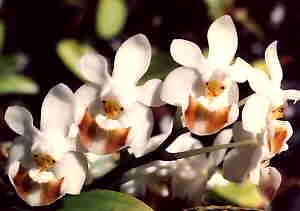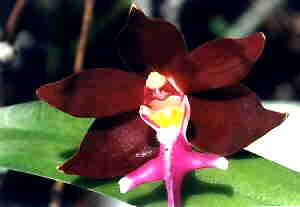|
|
|
CONTACT US
Click Here! |
| This site is best viewed with a screen resolution of 800 X 600 at high colour settings |
|
Flask List
Acacallis-Ancistrochilus Angraecum-Aspasia Barkeria-Broughtonia Bulbophyllum Capanemia-Catasetum Cattleya Cattleyopsis-Cycnoch, Cymbidium-Cyrtorchis Dendrobium-Dossinia Encyclia-Eulophiella Galeandra-Jumellea Laelia-Lycaste Macodes-Nephalaphyll, Odontogloss,-Oncidium Paphiopedilum-Psychilis Rangaeris-Stenocoryne Tainia-Zygopetalum |
|
Plant List
Acampe-Bulbophyllum Cattleya-Dossinia Encyclia-Promeaea Renanthera-Vanda |

BP SPECIES NEWSLETTER OCTOBER 2001
Photos: Phal lobbii right, Trichoglottis brachiata( below) Do
you know any friends who may like to receive this newsletter ? why not
forward this email to them now! Do
you know any friends who may like to receive this newsletter ? why not
forward this email to them now!
Email A. What's New in flask. Phalaenopsis sanderiana x sib is germinating. This pink flowered species comes from the Philippines. The two clones are good pink coloured forms somewhat like P. philippinense, with dark green black leaves, purple underneath. Phalaenopsis lobbii is germinating, a new SIB CROSS sowing to replace the remnants of the previous flasking. A sib cross between two good growing forms, we expect better flask results. We have held some orders for this until we get the newer flasking underway with better quality seedlings. Cattleya gaskelliana alba x self; a large flowered species
with white flowers to 15 cm, yellow in the throat.
B. What's ready to replate NOW.Cymbidiella pardalina ( Cymbidiella rhodochila ) is growing very well in flask and the replates have been started. This showy species needs conditions similar to Cymbidium, plus excellent drainage. It is a native of Madagascar where it grows in the Platycerum fern high in the trees. Maximun ventilation is necessary. Flowers to 7 cm, green to green yellow, the lip is red, petals green spotted black.Anoectochilus formosanus var varigata plants are now filling
their bottles. This has developed into a green leaf with large wide veins
and margins of yellow gold. We expect the eventual mature plants to be
strikingly varigated.This species does well in spaghnam moss, never dry,
but less water after flowerng.
C. What's new; Sarcs & Oncids; Black Orchids.The cross Sarcochilus cecileae x Parasarcochilus hirticalcar have started to flower. A more robust plant than cecileae, with somewhat larger flater flowers, with a darker pink colouration and some large purple spots on the sepals and petals. A showy minature. Oncidium wydlerii plants in 3 and 4 inch pots have robustly taken to the slotted pots and bark polystyrene mix. It flowers at a fairly small stage, with a spike of nearly 2 metres, branched, with many yellow flowers marked chestnut brown. Same group as spacelatum, multiflorumBLACK ORCHIDS Like black tulips, black orchids are flowers of the imagination. A few species of orchids have acquired the name "Black Orchid" by virtue of their very dark intense colour, while not black, which tends to the dark brown and maroon. One of the these is the Australian native orchid, Cymbidium canaliculatun var Sparkesii, a form that is a rich intense dark maroon, with a touch of white and dark purple on the labellum. A species of the drier open eucalyptus forest, it grows high in the trees from hollow branches and crevices. The seed germinates deep within the hollow or crevice and vines its way up until it reaches sunlight, where it then develops its pseudobulb. A feature seen in flasked seedlings filling a bottle with long vine like plants that, once potted, develop their bulbs on the end. Sparkesii, a pseudobulbous species, with stiff channelled leaves, a grower of the dry hot forest, requires a deep pot with a typical cymbidium media, lots of sunlight and maximum air ventilation. The spikes are produced in numbers and bear many deep maroon flowers which are fragrant. During the cooler part of the year, the plants need to be kept on the dry side. The Philippine "Black Orchid" is an entirely dfferent type of orchid. Trichoglottis brachiata ( or philippinense var brachiata) is an erect monopodial species that likes to climb. The plant will produce side shoots and grow into a specimen, with many flowers produced at the nodes along the stem. Each flower is up to 5 cm across, a rich velvety dark maroon, the lip prominently marked purple. The flowers are fragrant and long lived. The best results are had by having it grow up a piece of treefern or similar totem, as the new roots are always produced from the stem below the new leaves, so repotting into a pot or basket without a climbing support will not benefit the plant. An open media in a basket or slotted pot is best, a sunny spot and plenty of water and fertiliser when in growth will produce the best flowering. It is a tropical plant. Another species from the Borneo and Philippines region is Grammangis stapelliflora ( or Grammatophyllum stapelliflorum). This is a small growing bulbous plant much like Grammatophyllum scriptum. but the spikes are pendulous and bear a number of dark, chocolate maroon to red brown flowers. The flowers are up to 4 or 5 cm long, heavy textured. The species is tropical so requires a warm sunny place, a Cymbidium type media and a well drained basket or pot. At the start of new growth, copius water and fertiliser will encourage the flower spikes. After flowering a rest period is needed. Photos; see web page. With a little imagination, any collection would be enhanced with these
beautiful species, their colours and character so different. Text &
photos at web page Ian Walters.
D. Web page.Check out our web page http://www.speciesorchids.comThis is constantly under revision and you will find heaps of colour
photos, articles on species in cultivation and in the wild, plus links
to other interesting species orchids, and more photographs.
E. Humour.Quotes:From the Townsville Daily Bulletin, reporting on an agricultural show " The champion orchid was won by a rose grown by...." From a newspaper reporting floods " The pain in Spain is mainly due to rain". From a British newspaper reporting a lack of marriageable girls " Fewer openings for young men". At the risk of retaliatory limericks, you may like this dinner quip. An epicure dining at Crewe Found quite a large mouse in his stew Said the waiter don't shout And wave it about Or the rest will be wanting some too.
F. UnsubscribeTo have your name removed from the mailing list, email click hereTOP Yours in orchids, Ian and Pat Walters, Burleigh Park Orchid Nursery 54 Hammond Way, Thuringowa, Australia 4815 Email us at bporchid@ultra.net.au |
